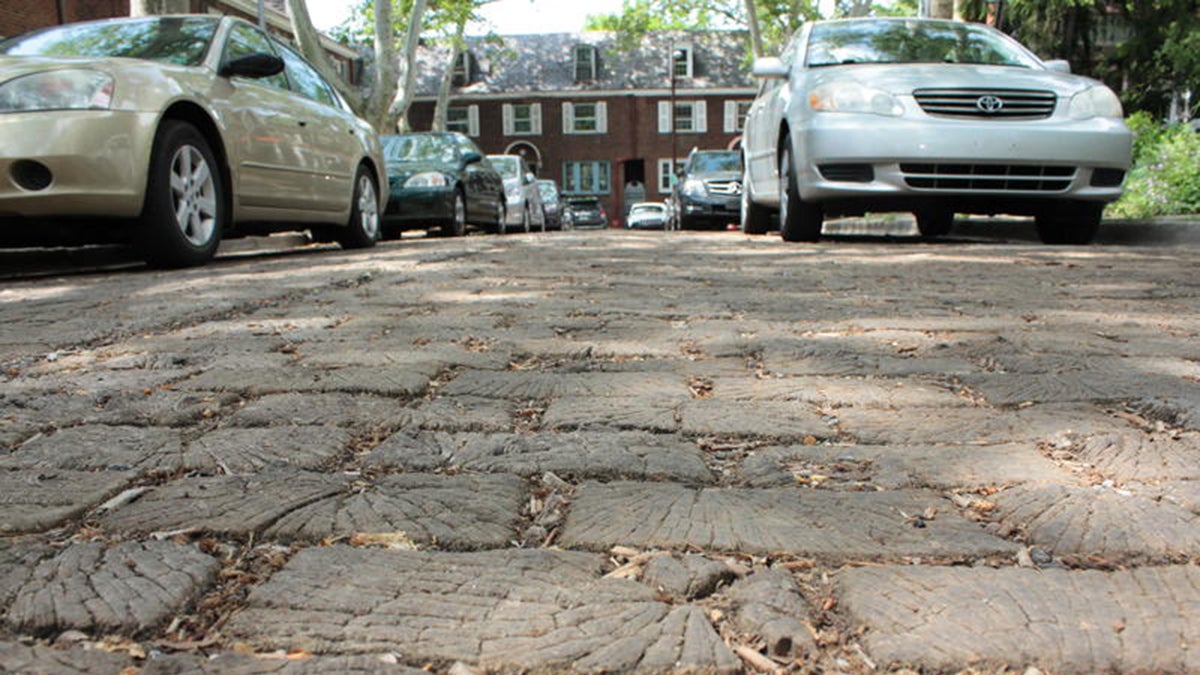A tale of two cities’ wooden streets

Roslyn Place, in Pittsburgh's Shadyside neighborhood, is one of the last wooden streets in the United States. It was recently designated a City Historic Site, which protects it from alterations. Philadelphia's wooden street, S. Camac Street, is covered with asphalt but is expected to be restored in 2018. (Margaret J. Krauss/WESA)
Separated by 303 miles and a layer of asphalt, two of the nation’s last wooden streets have had very different journeys.
Cobblestone, brick, asphalt: the commonwealth has an abundance of street-paving options. But there’s one we don’t talk about a lot: wooden blocks. Both Philadelphia and Pittsburgh are each home to one of the last wooden streets in the nation. A quick ramble through the interwebs turns up pages of stories about wooden streets. But if this story had been written 100 years ago, it likely wouldn’t merit publication. Wooden streets were about as common back then as fights over bike lanes are today. Between the mid-1850’s and early 1900s, wood streets were all the rage; everybody who was anybody was hopping on the Nicolson paving train, fitting wooden blocks tightly into streets. The trend had a lot going for it. For starters, horses and carriages traveling over stone pavers and bricks made an awful lot of noise, and contributed to innumerable cases of horse shin splints. (You try pulling a cart and walking on cobbles all day). It also didn’t hurt that wooden blocks were cheap. “Wooden streets in Pittsburgh were fairly common,” said Matthew Falcone, president of Preservation Pittsburgh, and a member of the city’s Historic Review Commission. But “as people moved toward automobiles, they just became completely irrelevant. They gradually started to disappear.” With a few notable exceptions. Once upon a time, Philadelphia’s S. Camac Street street was lined with granite blocks. They were ripped up and replaced with wooden blocks in 1917, and have vanquished the vagaries of weather, time, and paving trends ever since. That is, until they were covered in asphalt in 2015. Why were they asphalted over? As part of the city’s Historic Street Paving Thematic District Inventory, S. Camac was restored in 1998. But the blocks started to rot, bottom up, and became a safety hazard, said Steve Lorenz, Streets Department’s chief highway engineer.
He expects to restore the street by 2018. But it’s a cautionary tale for the city’s other historic streets. “If we don’t start making the investments in them, they’re going to start to fall a part and we’re going to lose those treasures in the next 50 to 100 years.” In Pittsburgh, Roslyn Place was the little street that could. It runs between two rows of homes inhabited by people stubbornly proud of their eccentric wooden blocks. When the city considered paving Roslyn Place in the 1980s, outcry was swift and persistent. The Department of Public Works completed a full restoration in 1985. Worried the street might never get that kind of love and care again, some neighbors still keep a small stash of leftover wooden blocks to make their own emergency repairs. The street has been honored as an historic landmark for many years, and the city has gradually come to recognize that protecting the past protects the future, said Karamagi Rujumba, director of public communications for the Pittsburgh History and Landmarks Foundation. “Our renewal, really, is based in the preservation and repurposing of those places.” However, the landmark plaque hanging on a nearby iron gate was mainly an honorific, and offered no real protection. Falcone’s organization, Preservation Pittsburgh, nominated Roslyn Place for a designation that would. Last week, Pittsburgh City Council voted to make the street a City Historic Site, which means it can’t be paved over. At least, not without making it past several levels of public scrutiny.
WHYY is your source for fact-based, in-depth journalism and information. As a nonprofit organization, we rely on financial support from readers like you. Please give today.


